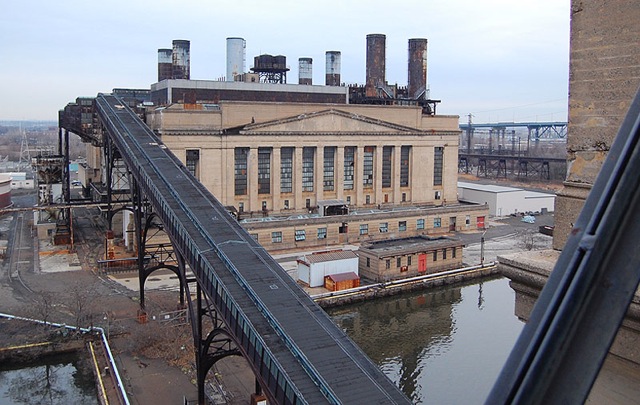
—"View from the coal tower over the Delaware," Ethan A. Wallace, photographer (© 2007)
Richmond Generating Station, 1925
Delaware Avenue and Lewis Street, Philadelphia PA 19137
© Jack J. Steelman,
Workshop of the
World (Oliver Evans Press, 1990).
The population increase in
the northeast section of the city in the early 1920s gave
rise to the need for an increase in Philadelphia
Electric's generating capability. At that time, the
Schuylkill and Delaware Generating Stations were the only
plants in the city, with the exception of the small and
outmoded Tacony Station adjacent to the Lardner's Point
Pumping Station. So the decision to construct a new
facility in Richmond was easily made.
As designed, the station was to contain three distinct
generating components; each component was to consist of a
boiler house to produce steam, a turbine hall, and a
switch gear building to control power distribution.
Generating steam pressure was designed to be 400 psi
instead of the customary 100 to 125 psi. Each of the
three turbine halls was designed to contain four tandem
compound turbo-generators that would ultimately each
produce 50 MW of power at 13.2 kV, for a total capacity
of 600 MW. Each boiler house was designed to contain 24
Babcock & Wilcox stoker-fired boilers.
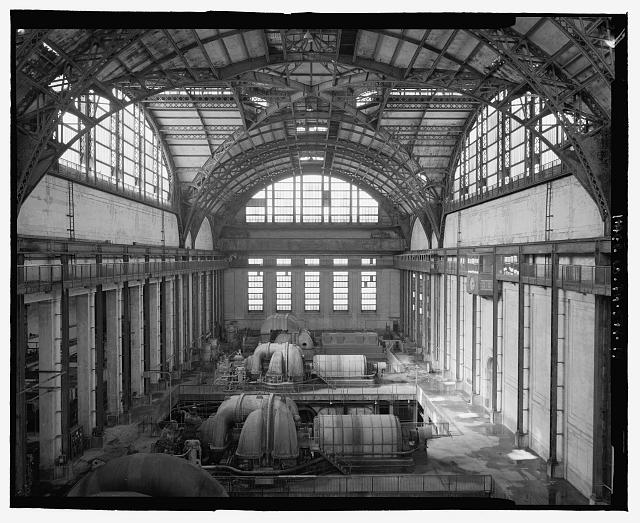
—"Turbine
Hall" is but one of 35 black & white photographs of
Richmond Generating Station taken for HAER in
2000 by Joseph E. B.
Elliott.
Only one of the three generating components was
constructed. Turbine Hall was one of the largest open
rooms ever designed, modelled after the ancient Roman
baths. Two of its four turbo-generator units were
installed and twelve of its 24 planned boilers were put
into place. The plant operated for ten years in this
manner; lack of anticipated power demands plus the
construction of the Conowingo Hydroelectric Facility on
the Susquehanna River in northeastern Maryland made
additional equipment and generating capability
unnecessary.
In 1935, a third unit rated at 165 MW (by Westinghouse)
was installed; it was powered by two pulverized
coal-fired boilers that gave it an effective rating of
135 MW. After World War II, it was overhauled and two new
stoker-type boilers were added; this extra bit of power
pushed the generating capability of the unit up to full
capacity.
In 1951, a fourth unit, rated at 185 MW was added; it ran
at a steam pressure of 1200 psi (as opposed to 400 psi).
Also, it was hydrogen-cooled instead of air-cooled like
the other units.
Water feed requirements of the high pressure boilers
necessitated a demand for extremely pure water. As the
water was taken directly from the Delaware River, a new
set of system evaporators was added. In this system water
was passed through strainers and filters; then was
softened, evaporated, and condensed at a rate of 50,000
pounds of water per hour.
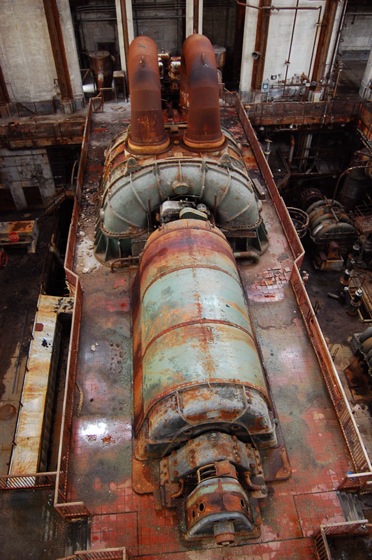
—"Looking down upon a
turbine," Ethan A. Wallace, photographer
(©
2007)
In the late 1960s, power demand from the burgeoning
northeast necessitated the installation of a series of
nineteen combustion jet-type turbo generator units at
Richmond. Eight of these units were built by Westinghouse
and rated at 25 MW each. Eight were built by Worthington
and consisted of two Pratt & Whitney jet engines
(similar in design to a 707 jet engine). These engines
were positioned back-to-back so that their exhausts were
directed into turbine casings that were attached to
generators capable of producing 40 MW each. The final
three units were heavy duty combustion turbines by
General Electric and rated at 60 MW each.
Richmond supplied power on four levels: the first was at
13.8 kV for large plant use such as the Sears Roebuck
plant or the Frankford Arsenal; the second level was 220
kV for large substations in the area as well as the
regional power grid; the third was 66 kV for nearby
substations; and the fourth level was for the
railroads—60 cycle, three-phase power was converted
to 25 cycle, single-phase power for the Northeast
Corridor.
The steam plant was shut down in 1984; all of the jet
units have been sold except for two of the GE units which
are still used during times of peak load. The switchyard
is still live. Presently, the metal in the plant is being
harvested for scrap and the asbestos is being removed.
Otherwise, the plant sits idle except during periods of
high demand.
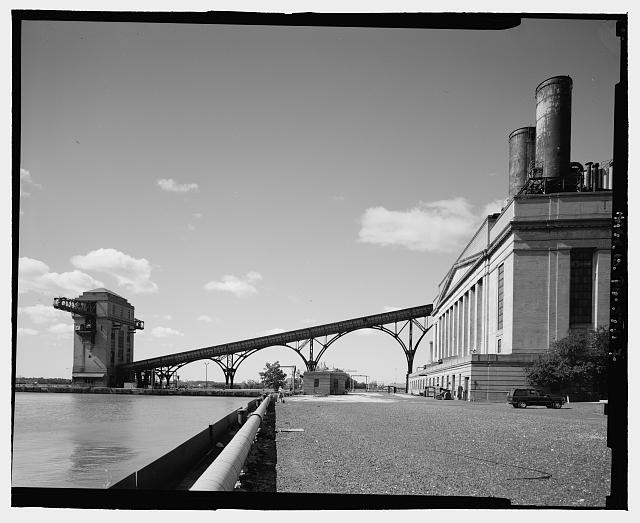
—"Coal conveyor", Joseph E. B.
Elliott (2000).
Update
December 2007 (by Ethan A. Wallace,
photographer):
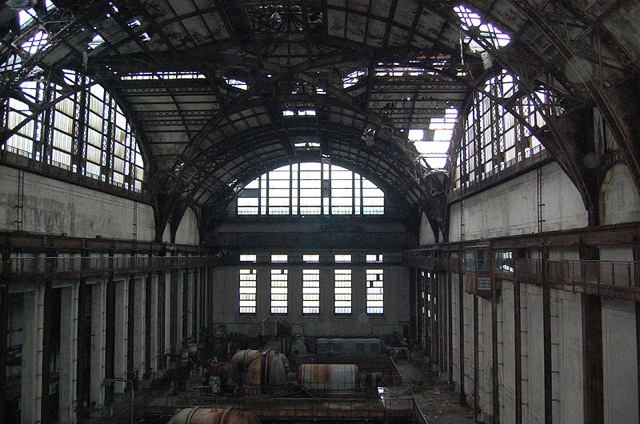
—Turbine Hall,
Ethan A. Wallace, photographer
(© 2007)
Approaching the main gate
from the North, the only sign that Richmond Generating
Station is still used at all is the light coming from the
windows of some of the small outer buildings. The
asbestos removal, one of the largest asbestos abatements
ever, has long been complete. Otherwise the place has
changed very little. Tools can still be found where they
were left; huge machines sit idle. Only the darkness and
the rust betrays how long this place has sat unused.
Some areas, such as the great domed turbine hall and the
long conveyor from the coal tower to the plant have holes
in the ceiling and missing windows. Moss grows on
permanently damp floors and rust threatens to eat through
gratings that make up much of the upper floors. The roof
still reveals copper trim around all the skylights and
windows, despite the fact the scrappers have begun to
loot the building for anything of value. From the roof as
well as through numerous missing windows you can hear the
electric buzz of the still active switch yard on the
plant’s south side.
The oddest things in Richmond have nothing to do with its
original functions. The building was one of the locations
used for the movie Twelve Monkeys and artifacts for the
film can still be found throughout the structure. Doors
bear false names such as The Bunker, or Infirmary, cans
of paint labeled after the set they were for sit in the
halls. In one spot there was a pile of old x-rays, some
bearing the legend Pennhurst State School on the bottoms.
In the midst of one room is a plywood wall with a window
and what appears to be the front of an MRI machine
connected perpendicular to it.
While the fate of Richmond is not clear, there is an
immediate threat to this historical and beautiful
building. Sawn-off pipes and missing trim stand as
evidence of scrapping activity in the plant. In fact
while we were photographing the turbine hall from the
upper level, two scrappers entered down by the turbines
and proceeded to saw off and remove some of the
pipes.
-----
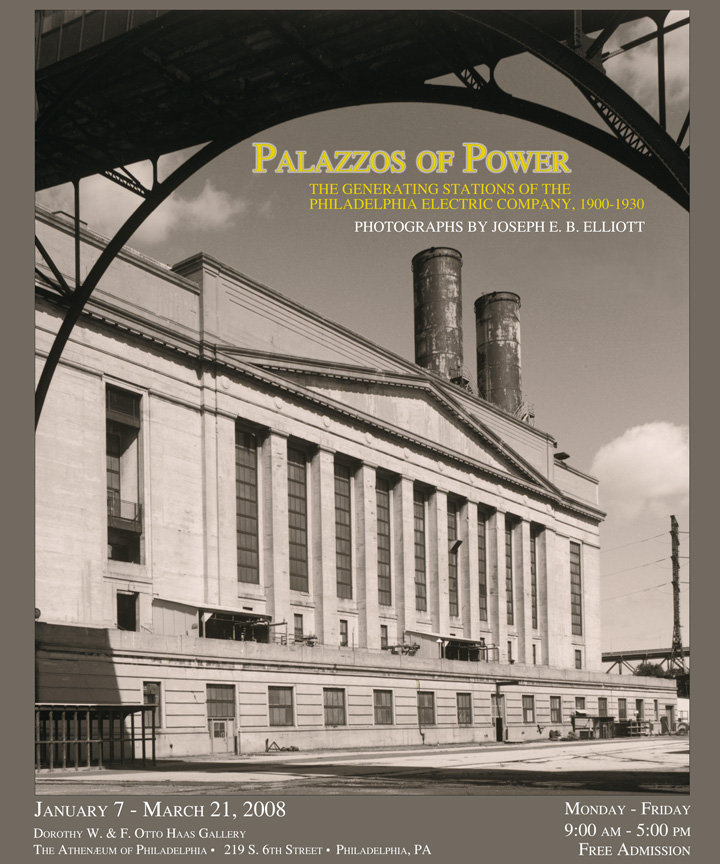
—Palazzos of Power exhibit
details.